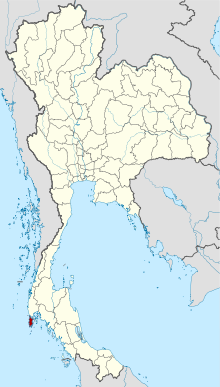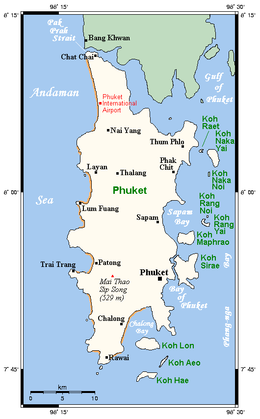Phuket, Thailand
|
Phuket ภูเก็ต |
||
|---|---|---|
| Province | ||
|
||
 Map of Thailand highlighting Phuket Province |
||
| Country | Thailand | |
| Capital | Phuket City | |
| Government | ||
| • Governor | Noraphat Plotthong (since April 2017) | |
| Area | ||
| • Total | 576 km2 (222 sq mi) | |
| Area rank | Ranked 75th | |
| Population (2015) | ||
| • Total | 386,605 | |
| • Rank | Ranked 68th | |
| • Density | 1,042/km2 (2,700/sq mi) | |
| • Density rank | Ranked 6th | |
| Time zone | ICT (UTC+7) | |
| ISO 3166 code | TH-83 | |

Map of Phuket (beaches in brown)
|
|
| Geography | |
|---|---|
| Location | Andaman Sea |
| Coordinates | 7°53′24″N 98°23′54″E / 7.89000°N 98.39833°E |
| Area | 576 km2 (222 sq mi) |
| Length | 50 km (31 mi) |
| Width | 20 km (12 mi) |
| Highest elevation | 529 m (1,736 ft) |
| Highest point | Khao Mai Thao Sip Song |
| Administration | |
|
Thailand
|
|
| Demographics | |
| Population | 386,605 (2015) |
| Pop. density | 1,042 /km2 (2,699 /sq mi) |
Phuket (Thai: ภูเก็ต, [pʰūː.kèt]) is one of the southern provinces (changwat) of Thailand. It consists of the island of Phuket, the country's largest island, and another 32 smaller islands off its coast. It lies off the west coast of Thailand in the Andaman Sea. Phuket Island is connected by the Sarasin Bridge to Phang Nga Province to the north. The next nearest province is Krabi, to the east across Phang Nga Bay.
Phuket Province has an area of 576 square kilometres (222 sq mi), somewhat less than that of Singapore, and is the second-smallest province of Thailand. It formerly derived its wealth from tin and rubber, and enjoys a rich and colorful history. The island was on one of the major trading routes between India and China, and was frequently mentioned in foreign ship logs of Portuguese, French, Dutch, and English traders. The region now derives much of its income from tourism.
There are several possible derivations of the relatively recent name "Phuket" (of which the digraph ph represents an aspirated p): It is either derived from the word bukit (Jawi: بوكيت) in Malay which means "hill", as this is what the island appears like from a distance. Or the name originates from two Thai words, "phu" (mountain) of "ket" (jewel), and this is said to be recorded in a Thai chronicle.
Phuket was formerly known as Thalang (ถลาง Tha-Laang), derived from the old Malay "telong" (Jawi: تلوڠ) which means "cape". The northern district of the province, which was the location of the old capital, still uses this name. In Western sources and navigation charts, it was known as Jung Ceylon or Junkceylon (a corruption of the Malay Tanjung Salang, i.e., "Cape Salang"),
...
Wikipedia

